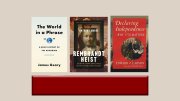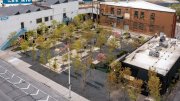For almost three centuries, Massachusetts Hall has stood quietly at the entrance of Harvard Yard. It is perhaps more quintessentially Harvard than any other building, for as a central part of the Yard and as the oldest building on campus, it has over time come to represent the University on everything from postcards to banners to china plates. (The only older American college building is the Christopher Wren administration building at William and Mary.) "It's a friendly, kindly old building," recalls William C. "Burriss" Young '55, who lived in Mass Hall for 35 years as an assistant dean of freshmen.
Administrators and students hold the building in special regard. For within its thick brick walls, for more than six decades, the University administration has coexisted peacefully with the College's youngest and newest students. Over the years, those who have lived within Mass Hall have formed a special bond with one another--a bond that stretches back through generations of Harvard alumni and includes such famous people as the nation's second president, John Adams, class of 1755, who shared a triple on the northwest corner of the first floor.
From the outside, the elegant old building has changed little since it was built in 1720: an enormous clock was added to the west end in 1725 and decorative ironwork was removed in the 1800s. Inside, though, the building has evolved along with the University. What began in 1720 as an answer to the perennial issue of student overcrowding has been reincarnated regularly ever since: as military barracks, lecture halls, reading rooms, lab space, and most recently as offices for the president, provost, general counsel, vice presidents, and their various support staff on the first two floors and as home to 24 first-year students and a proctor on the third and fourth floors. Yet even now the building's layout remains subject to change: the room in which Young lived for more than three decades was converted to administrative use during President Neil L. Rudenstine's tenure to help make room for the new office of the provost.
Massachusetts Hall's storied history began as Harvard College expanded to meet the growing size of Puritan Massachusetts in the early eighteenth century. The University Overseers petitioned the General Court, the colony's governing body, to build a new residence with public funds and relieve the pressure on Old Stoughton, then the University's only dormitory. The "Numbers of the Sons of Prophets are now so increas'd," they wrote, "that the Place where they were wont to dwell is become so Streight." After two years of legislative wrangling and budget cuts, the result was Mass Hall, completed at a cost of £3,500--£116 pounds under budget. The Early Georgian style of Mass Hall marked a "considerable advance" over previous buildings, noted Harvard scholar Bainbridge Bunting in his book, Harvard: An Architectural History. It was meant to house 64 students, but two rooms were designated for tutors and another became the "Apparatus Chamber," a forerunner of later scientific laboratories.
During the Revolutionary War, the University offered the dorms to the Continental Army as barracks. At the peak of the siege of Boston, 640 Continental soldiers lived in the building's 32 chambers--residents who managed to wreak more havoc in their short stay than any others past or since. After the soldiers left, the University reported that much of the interior woodwork and many of the brass doorknobs and locks were missing or destroyed.
While most know it now as an administrative building or dormitory, Mass Hall also has a rich academic tradition. During the 1740s, it held the first experimental physics lab in America, that of Hollis professor of mathematics and natural philosophy John Winthrop. In the 1870s, President Charles William Eliot, desperate for more classroom space, gutted the building to construct four large spaces to be used as classrooms, examination rooms, or labs as needed. Then the building was renovated into office space, but, after a fire in 1924, became a dormitory yet again. In 1939, the lower floors were given over to the president's office (which had been in University Hall) and the building assumed its modern look.
Beyond its constant physical presence, Mass Hall also offers a deep trove of University lore. Certainly the students who live there share a unique College experience: their proximity to power. "After all, no one else had the president downstairs," says former resident Nancy Kerrebrock '79. Egils Milbergs '68 can recallhow he greeted Nathan M. Pusey '28 on many a morning when the president was arriving at work and Milbergs was leaving for breakfast. Neil Rudenstine continued the association with pizza dinners. During this spring's "living-wage" takeover, residents drafted a letter asking the protesters to respect the old building and the staff downstairs and later joined the president's staff for a special ice cream bash to celebrate the building's liberation. (Although Rudenstine's generosity on that occasion was admirable, perhaps he was only repaying a centuries-old debt: in the beginning, the rent collected from student residents was used to supplement the president's official salary.)
One of the University's better-known myths centers on the "golden children" of Mass Hall. As they lead groups past the building, Crimson Key tour guides whisper of the quiet introverted undergraduates--now both the Sons and Daughters of the Prophets--housed in the dorm, hand-picked as the "crème de la crème" of the student body to ensure that the president can work undisturbed beneath them. In some respects, the myth is true.
The idea of the "golden children" was Young's. Young, joined for a period by his dog, Tizzy, lived in room A-31 from 1961 until 1996 and served as the building's proctor. He asked for the assignment because of Mass Hall's lore and its comfortable quarters--including giant fireplaces. Once he moved in, he picked the first-year students who would join him each year. "At the end of the day," he explains, "I wanted to come home to pleasant kids."
Thus, his criteria encompassed curiosity, intelligence, and pleasantness--criteria that often led him to an eclectic bunch of students. For their part, Young's "golden children" recall being puzzled at their selection. As Nancy Kerrebrock explains, they often spent their first days in the dorm asking, "Why would anyone hand-pick us?" Nonetheless, the building became a defining part of their time at Harvard. Dean Young would hold court in his room in the evenings, sometimes treating his students to a "home-cooked" meal from a hibachi parked in the fireplace. The residents remained close, and as his time at the College passed, Young found himself being asked to house the "legacy" children of former students. A dozen former Mass Hall residents from the Class of 1976 held a mini-reunion with him this past spring.
The "golden children" stories, though, are belied by other University myths which hold that the University banned kegs after Mass Hall residents soaked the president of France with beer. The story begins when residents tried to wash out a keg in their shower and the drain clogged; the water then leaked through the ceiling and into the office of then president Derek C. Bok, who was meeting with François Mitterand. But Bok has denied the rumor and Young likewise laughs it off: "Nothing could leak through those ceilings. That building is too well-built."
That is not to say, though, that Young didn't see his share of problems with alcohol during his tenure. However, his students--for the most part--blamed any hidden liquor on Holbrook Smith, the ghost of Mass Hall, who reportedly visited students for many years. Smith--a "tall respectable-looking older gentleman," according to Young--claimed to be a member of the class of 1914, but no one could ever locate such an alumnus. He liked to drop in and chat with the students in the B-entry of the building during the first few weeks of each term; everything about the man seemed normal except that he never had to open or close a door to enter or leave the dorm. One fall, student complaints forced Young to confront Smith. Young asked him to leave, and he recalls that Smith looked at him with "the saddest eyes I've ever seen. He said, 'You've ruined a perfectly good thing.'" And with that, Smith walked down the stairs never to be seen again.
Although the exchange with Smith was Young's only face-to-face meeting with a ghost during his time in Mass Hall, students over the years have reported many encounters with supposed phantoms. Young sees Mass Hall as a natural place for spirits of Harvard's past: "Eighteenth-century buildings should have ghosts. If there are going to be ghosts, it makes sense they should live in the nicest building in the Yard."





